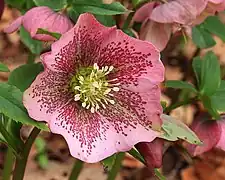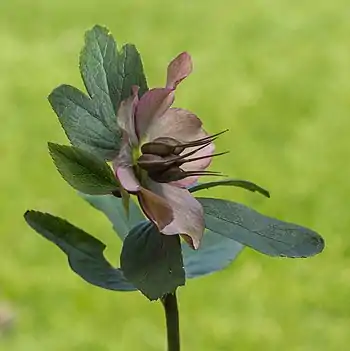Helleborus orientalis
Helleborus orientalis, the Lenten rose,[1] is a perennial flowering plant and species of hellebore in the buttercup family, Ranunculaceae, native to Greece and Turkey.[2]
| Helleborus orientalis | |
|---|---|
 | |
| Scientific classification | |
| Kingdom: | Plantae |
| Clade: | Tracheophytes |
| Clade: | Angiosperms |
| Clade: | Eudicots |
| Order: | Ranunculales |
| Family: | Ranunculaceae |
| Genus: | Helleborus |
| Species: | H. orientalis |
| Binomial name | |
| Helleborus orientalis | |

Description
This perennial reaches 28–45 cm (11–18 in) tall, with glossy green palmate leaves composed of 7–9 leaflets with serrated leaf margins. Leathery in texture, the leaves are evergreen. The cup-shaped pendent flowers appear in late winter and spring, arising in groups of 1–4 on the ends of thick stems rising above the foliage. They have yellow stamens.[3] All parts of the Lenten rose are poisonous.[3] Sap coming into contact with the skin may cause temporary irritation, while ingestion of large quantities can cause burning of mouth and throat, vomiting, abdominal cramping, and diarrhea.[4]
Taxonomy
Jean-Baptiste Lamarck described the species in 1789, giving it its current name of Helleborus orientalis ("Hellébore du Levant").[5] Within the genus Helleborus, it has been classified in the section Helleborastrum, and is closely related to the other eight species in the section.[6] These species are all highly variable and hybridise with each other freely.[7]
The Latin species name orientalis means "eastern".[8] The common name "Lenten" refers to the period of Lent.[9][10]
Cultivation
The Lenten rose is suited to shaded or part-shaded positions, in soil rich in humus. Cultivated varieties have a wide array of colours.[3] It is hardy in USDA hardiness zones 4–9 (down to −15 to −20 °C (5 to −4 °F)).[11] German planters began breeding H. orientalis in the mid-19th century, enhanced by new material from the Caucasus via St Petersburg Botanic Garden. New varieties were soon introduced to the United Kingdom. Interest peaked in the late 19th century, but the genus had fallen out of favour by the 1920s.[12] The Lenten rose was revived in horticulture in the 1960s by Helen Ballard, who bred many new varieties.[13] Cultivated varieties can have white, green, pink to maroon and purple or spotted flowers.[14]
References
- BSBI List 2007 (xls). Botanical Society of Britain and Ireland. Archived from the original (xls) on 2015-06-26. Retrieved 17 October 2014.
- "Helleborus orientalis Lam". Flora Europaea. Royal Botanical Garden Edinburgh. Retrieved 29 January 2015.
- "Helleborus orientalis". Plant Finder. Missouri Botanic Garden. Archived from the original on 6 January 2018. Retrieved 6 January 2018.
- "Helleborus orientalis (Christmas Rose, Helleborus, Lenten Rose) | North Carolina Extension Gardener Plant Toolbox". plants.ces.ncsu.edu. Retrieved 2021-02-26.
- Lamarck, Jean-Baptiste (1789). Encyclopédie méthodique. Botanique. Vol. 3. Paris,Liège: Panckoucke; Plomteux. pp. 96–97. Archived from the original on 2018-01-25.
- Zonneveld, B.J.M. (2001). "Nuclear DNA contents of all species of Helleborus (Ranunculaceae) discriminate between species and sectional divisions". Plant Systematics and Evolution. 229 (1–2): 125–30. doi:10.1007/s006060170022. S2CID 22172693. Archived (PDF) from the original on 2018-01-06.
- Hang, Sun; McLewin, Will; Fay, Michael F. (2001). "Molecular Phylogeny of Helleborus (Ranunculaceae), with an Emphasis on the East Asian-Mediterranean Disjunction". Taxon. 50 (4): 1001–18. doi:10.2307/1224717. JSTOR 1224717.
- Simpson, D.P. (1979). Cassell's Latin Dictionary (5 ed.). London: Cassell Ltd. p. 416. ISBN 0-304-52257-0.
- Schronce, Arty. "Lenten Rose – A Perennial Getting Some Well Deserved Attention". Market Bulletin. Georgia Department of Agriculture. Archived from the original on 6 January 2018. Retrieved 6 January 2018.
- "Helleborus orientalis". Gardeners World. Archived from the original on 6 January 2018. Retrieved 6 January 2018.
- "Helleborus orientalis". RHS. Retrieved 7 December 2021.
- Kingsbury, Noel (2016). Garden Flora: The Natural and Cultural History of the Plants In Your Garden. Timber Press. p. 156. ISBN 9781604697735. Archived from the original on 2018-01-06.
- Terry, Bill (2015). The Carefree Garden: Letting Nature Play Her Part. TouchWood Editions. p. 115. ISBN 9781771511261. Archived from the original on 2018-01-06.
- Cretti, John; Newcomer, Mary Ann (2012). Rocky Mountain Gardener's Handbook: All You Need to Know to Plan, Plant & Maintain a Rocky Mountain Garden – Montana, Idaho, Wyoming, Colorado, Utah, Nevada. Cool Springs Press. p. 115. ISBN 9781610588195. Archived from the original on 2018-01-06.
External links
 Media related to Helleborus orientalis at Wikimedia Commons
Media related to Helleborus orientalis at Wikimedia Commons